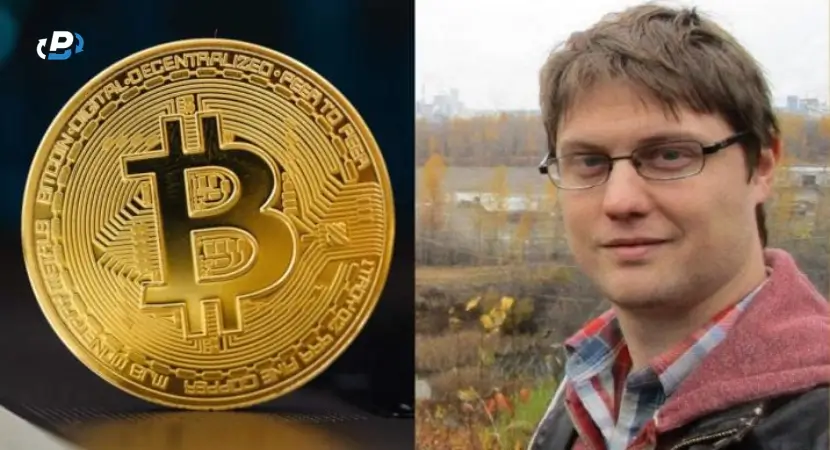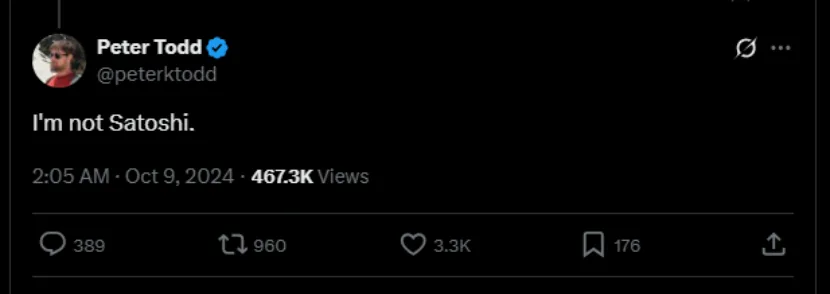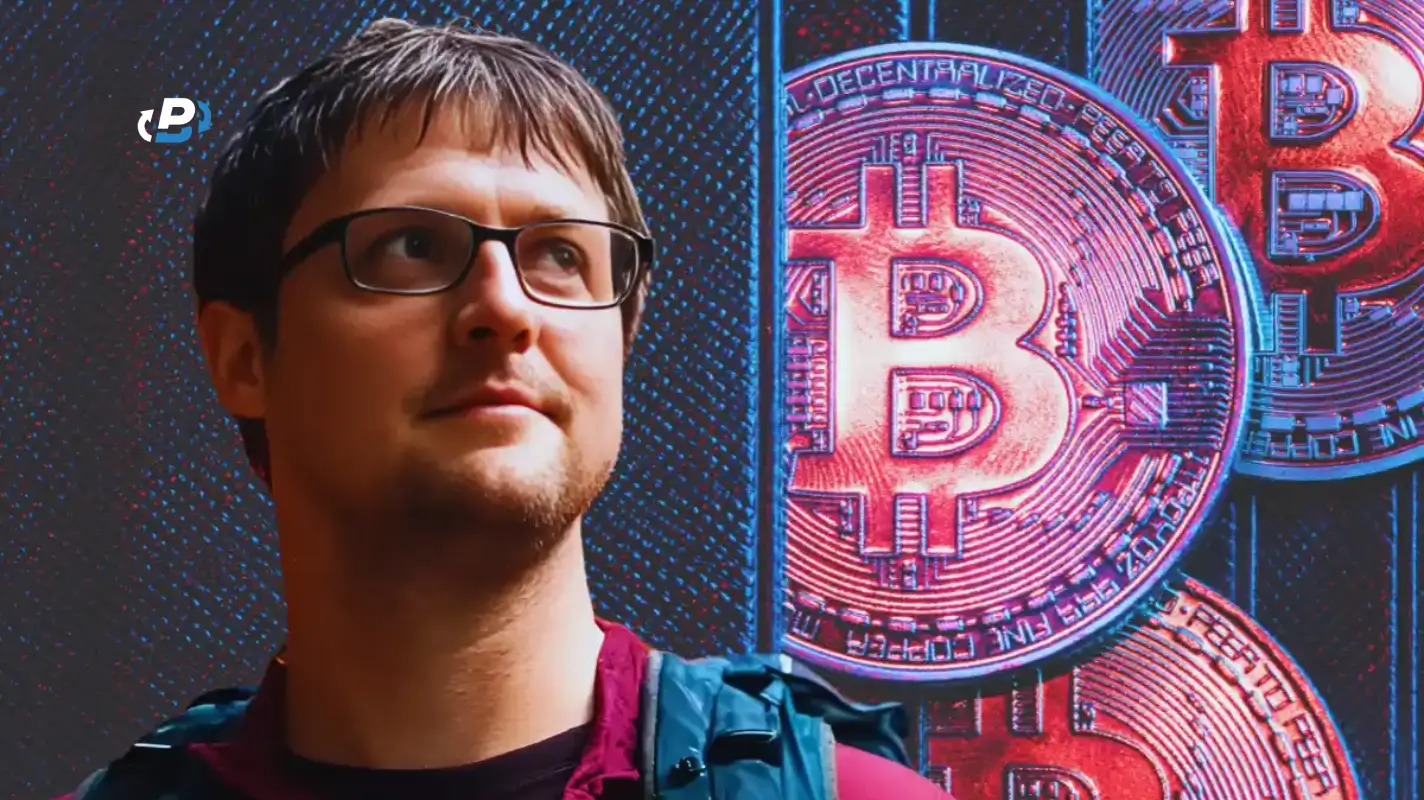Keeping track of time is a huge headache because of time zones, leap seconds, leap days, daylight saving time, different calendars, and the pope changing the date by decree. Add in computers, where every millisecond matters, and the headache just got ten times worse. Every solution we come up with causes even more problems, but a guy named Peter Todd figured out a timekeeping solution by using Bitcoin’s blockchain as a calendar, which could be just the beginning of amazing uses for Bitcoin. Who is Peter Todd? He is a Canadian cryptographer and Bitcoin Core developer who has worked on Bitcoin since 2010, and contributed and advised to projects like Blockstream, OpenTimestamps, Verisart, and Dark Wallet. In October 2024, HBO’s documentary Money Electric: The Bitcoin Mystery claimed he is Satoshi Nakamoto, but Todd has repeatedly denied the allegations. Following the documentary's release, he faced increased scrutiny, financial requests, and security concerns, leading to reports that he went into hiding, though he later refuted this, stating he remains active in the Bitcoin community.

Peter showed us that the BTC blockchain could hold a plethora of amazing non-monetary uses
Peter’s Early Life and Later Notoriety
Peter dabbled in designing electronics as a kid and worked on several low-profile cryptography projects in early adulthood. He got involved with Bitcoin as an adult, just in time to talk with Satoshi Nakamoto about transaction fees, and even managed to score some BTC when it was priced at 20 cents. People could recognize who is Peter Todd by his inflammatory style of arguing because Peter was notorious for being a contrarian and outright saying, “You’re all wrong.” That provocative attitude got him in trouble in the HBO documentary Money Electric: The Bitcoin Mystery, where he jokingly admitted to being Satoshi Nakamoto, causing a stir to the point that he had to tighten up his security to avoid harassment and possible kidnapping. Now he denies being Satoshi, and he’s all serious about it, calling the documentary “irresponsible” and saying the documentary creator, Cullen Hoback, is “grasping for straws.”

Unlike other crypto influencers, Peter Todd vehemently denies being Satoshi
Is Peter Todd Satoshi? Not a Chance In Hell
Over the years, there have been many contenders for the title of One True Satoshi. From Nick Szabo to Roger Ver and Craig Wright, they’ve all had some involvement with Satoshi Nakamoto, which they used to claim they are Satoshi. Peter Todd also had contact with Satoshi around the same time, but he denies being Satoshi. Is Peter Todd Satoshi? Probably not, but we have this supporting evidence: his interaction with key Bitcoin developers like Hal Finney and Adam Back as a teenager, one forum post where he mentioned “sacrificing” Bitcoin and destroying access to it, as if he admitted to losing access to Satoshi’s wallet on purpose, and a December 2010 BitcoinTalk thread in which Todd posted after Satoshi’s post.

The most substantial piece of evidence that Peter Todd is Satoshi
In the BitcoinTalk thread titled “Fees in BitDNS confusion,” a new user asked if he will be able to make a decision regarding Bitcoin transaction fees, seeing how the code currently doesn’t allow it. Satoshi explained that there is room for growth in Bitcoin code that can come “far in the future” and that involves sending the same transaction twice. Peter replied right after it, stating his opinion in a way that can be interpreted as if he was either correcting Satoshi or correcting himself.
Peter Todd XRP Review and Twitter Post
In 2015, Peter published a scathing 16-page review of XRP, calling it poorly scalable, centralized, prone to attacks, and controlled by Ripple Labs which doesn’t provide any way to securely download their software. 10 years later, his big mouth will again cause him trouble and lead to the Peter Todd XRP stunt. On Feb 23, 2025, Peter Todd made a post on Twitter with just the word “xrp,” later explaining that someone at the Heat Punks Bitcoin Mining Conference dared him to do it for engagement. After being asked for further explanation, he attached his review. Peter is known for being a long-time critic of XRP, arguing that XRP serves no real purpose other than enriching Ripple Labs and calling XRP a centralized token. He later reaffirmed his belief that including XRP in a reserve system would be a scam benefiting centralized entities, which makes the engagement stunt even more baffling.
Peter’s Many Hats
In 2022, Peter opened a Stacker News ask-me-anything thread where he described himself as a web-π developer, which presumably refers to decentralized apps made in Python for the Web3 Pi Browser. There he also said he is a “cryptochronomancer,” which I gather refers to chronomancy, the dark art of predicting the future and manipulating time, and cryptography. Peter shows deep fascination with time, time travel, and keeping track of time, at one point even saying that one tweet about Bitcoin sent back to his younger self would help him make Bitcoin on his own. He also shares interesting tidbits about himself, such as how he got involved in BTC.

Peter's main motivation for tinkering with cryptos was censorship-resistant publishing
On his GitHub profile, Peter described himself as an applied cryptography consultant, a role for which there is no description, but it probably means finding ways to use cryptography for better security. He eventually focused on his idea of OpenTimestamps, an open-source project for decentralized timestamping by using Bitcoin’s blockchain, which is reminiscent of Nick Szabo’s concept of timestamping bit gold. Peter also runs a blog where he occasionally posts his ideas on improving Bitcoin, such as a cool idea on mining it in space to keep the costs down.
Peter’s Opinion on Bitcoin and the Crypto Community
The January 2019 episode of The Peter McCormack Show gave us more insights into who is Peter Todd as he appeared there as a guest and laid out his views on Bitcoin. In his opinion, Bitcoin is closer to what money should be compared to something like PayPal which tried to be an anonymous payment method but failed because it couldn’t overcome legal barriers. He sees Bitcoin as decentralized and more resilient to adversaries as opposed to PayPal, which is centralized and vulnerable to takedowns and interference. In Peter’s view, cryptocurrencies matter for journalists who deal with controversial topics, and they also prevent payment platforms from cutting off the flow of funds to controversial publishers. When asked to define Bitcoin, Peter said: “Bitcoin is a shared data structure that we make artificially expensive to change by destroying energy every time we update it [because] Bitcoin uses proof of work to make changes to the ledger difficult.”
He thinks that Bitcoin won’t grow much more and that there is no chance of another 10,000x because the world economy is not big enough to support it. But, he says it is good that Bitcoin is valuable since its security model depends on its price. He is impressed by Monero, which is something he tends to say often, and laments the fact that Zcash isn’t doing better. As for the abundance of projects in the cryptocurrency ecosystem, many of which fall apart or turn out to be scams, he said: “People are polluting the ecosystem of ideas with false things.”
What Does Peter Todd Bitcoin Address Use Reveal About Him?
From what I discovered, Peter is not into using Bitcoin as money, though he did do it at one point, perhaps to run tests or to prove a point. Peter’s main motivation for tinkering with Bitcoin is to piggyback on it for the purpose of timekeeping. However, we do know Peter’s Bitcoin wallet address and can glean some info from it. What is Peter Todd Bitcoin address? His Bitcoin address is 1FCYd7j4CThTMzts78rh6iQJLBRGPW9fWv, according to his profile on Bitcointalk.org. It's currently empty, with a total amount of over 50 Bitcoins (around $4.4 million as of March 2025) received and sent and a total volume of 101 BTC. The last transaction was a payment of 0.15479083 BTC to another address that happened on May 18, 2023.
OpenTimestamps, Peter Todd’s Magnum Opus
Peter’s main project is OpenTimestamps, a decentralized, public timestamping service made in Python that uses Bitcoin’s blockchain to provide a cheap, trustless, and convenient way to prove that some data existed in the past. Peter started working on OpenTimestamps part-time in June 2012 and then quit his job in December 2014 to work on it full-time. By September 2016, he had rewritten the code from scratch and launched the public alpha release. Though it doesn’t seem like it does much, OpenTimestamps could be a genuine game-changer. It was already used in the 2023 Guatemalan elections to prove that nobody added votes after the voting ended. It basically works by checking the block creation time on the Bitcoin blockchain, but it doesn’t require any Bitcoin to be spent. Every block on the Bitcoin blockchain has data fields with additional information, such as the time when the block was created, and it’s all inside an 80-byte header.
The creation time is not completely precise and is probably within a few hours of the actual block creation time and very likely on the same day, which is good enough for OpenTimestamps. When a user wants to timestamp a file or some message, the OpenTimestamps client finds the most recent Bitcoin block, gets its header, and puts the time when it was created through a one-way encryption process called SHA-256 together with the file or message the user selected. The timestamp is created within a second by using the data from a publicly auditable Bitcoin block header. The result goes to Peter’s aggregation servers, where it waits for other requests, and then is processed in batches and recorded on Peter’s calendar servers. He admits the servers he’s running are a vulnerability because they can be taken offline, but he also says they can be easily replaced and the data can be copied by someone else to keep the service alive. The best part is that the process is private, and nobody sees the file or the message, only the outcome of the SHA-256 hashing. It is theoretically possible that two different files or messages produce the same SHA-256 hash or to reverse the hashing, but the possibility for either is considered so remote that it’s accepted as impossible.
Using a Blockchain To Prove Authenticity
The idea of using a blockchain to timestamp some digital data can be applied to art as well. Verisart is a Los Angeles startup that got the idea of creating a public blockchain that provides authenticity data about artwork without exposing the personal information of buyers and sellers. Artwork is an asset that generally increases in value as time goes on, making it an appealing investment, except if the artwork turns out to be a forgery. How can you tell if it is? Well, you have to find a trusted third party and pay it to run authenticity tests. Anyone who buys the same piece of art has to find other trusted third parties and run more authenticity tests, which is a huge waste of time and money. Verisart’s approach is that the easiest way to know if a piece of art is authentic is to know who made it and who bought and sold it, but that is very difficult to do online or with digital art, which to me seems like yet another reason why NFTs failed so miserably. Verisart knew who is Peter Todd and brought him in as a board advisor and to help create cryptographic tokens that can be published on the blockchain for everyone to check without revealing prior buyers and sellers.
The Decentralized Timestamping Revolution
Peter’s idea of auditable, decentralized timekeeping through a blockchain is a genuine game-changer. Timekeeping is difficult and expensive, yet you need it for any kind of transaction, and the richer the transaction, the more precise you have to be. Take real-life contracts as an example. They all have the date on them, which is basically a timestamp made according to the official calendar, and usually have time-sensitive clauses, something like “this contract ends two years after signing.” Without timekeeping, nobody could determine when a contract started and when it’s supposed to end, and all contracts would have to be made for life, which would not hold up in court. With timekeeping, the parties to the contract can use more nuanced clauses to make fairer contracts and also do profitable international business.

The official calendar has to be maintained by someone, usually a trusted third party, such as a government, and because governments don’t trust each other, they all have their own variations of the same calendar, which is how we have 24 time zones in the world. If you look up time zones and how they criss-cross the planet, you’ll see that they mark areas of administrative control rather than geographical areas. Belonging to a time zone is voluntary, and a government can switch from one time zone to the next by decree. In 2011, the Pacific nation of Samoa skipped a day ahead, from December 29 to December 31, to be more in sync with its main trading partners, New Zealand and Australia. The neighboring American Samoa stayed in the old time zone, making the time difference between the two islands separated by 50ish kilometers an entire day.
How Samoans and a Pope Changed Their Calendars at Will
Samoa is home to some 200,000 people, and it’s no big deal if its government fiddles with the local calendar, but religious leaders, such as popes, who used to have king’s powers and commanded standing armies, can skip an entire week for everyone. On February 24, 1582, Pope Gregory XIII issued a decree titled “Inter gravissimas” that added 10 days to the calendar, skipping from October 4 to October 15, and created the Gregorian calendar that is still in use today. The time skip was because the previously used calendar, which was made by Julius Caesar, counted a year as 365.25 days long when it was actually 365.2422 days long. Over centuries, those 11 minutes and 14 seconds added up to the 10 days of drift, which caused significant problems in how dates of major Christian holidays were calculated. The Orthodox Christian Church refused to follow the Gregorian calendar and is still observing the Julian version, which is why Orthodox Christians celebrated their holidays 10 days after the Catholics, which is by now a 13-day difference.
Preventing Future Crises With Timekeeping
A public timekeeping solution like OpenTimestamps might also help the world avoid or minimize systemic problems that arose in the 20th century because of the cost of keeping track of time locally. It sounds strange, but computers don’t have a universal way to keep track of time, and that’s a really big problem that everyone ignores until it becomes a crisis. We already had one of those crises that people ignored until it was about to manifest, and as soon as it was resolved, they forgot about the root cause and kept on trucking. In the 20th century, computer memory was expensive, and programmers tried to save it whenever they could, so instead of writing down years as four digits in software, they used only the last two. There’s no way their programs would be used for decades, right? That’s exactly what happened, and the problem didn’t become apparent until the late 1990s, which is when the media started crowing over the impending civilization collapse dubbed the “Y2K problem.” Programs that worked fine up until 31 December 1999 would the next day switch over to the year 2000 and possibly interpret it as 1900, which could mess up transactions, systems, and files. The outcome was not as catastrophic as everyone assumed, likely because the global society wasn’t as dependent on computers and the internet as we are today, but we’re headed for another similar crisis, this time in 2038.

Animation that shows the Unix seconds counter resetting to year 1901
The aptly called “Y2K38 problem” is because Unix servers use a 32-bit number to count seconds since January 1, 1970. The number can at most count to 2.147 billion seconds, which runs up to January 19, 2038, after which the number will overflow and go to December 13, 1901, potentially messing up transactions, systems, and files. According to the stats I found, Unix is running on about 90% of all public web servers, and based on what I’ve seen with Y2K, people will wait until the late 2030s to start dealing with Y2K38, after which point they will all just keep on trucking. Those are just the two biggest examples, and there are numerous smaller examples of the same problem, such as with GPS navigation, and it’s all because of how we save time by saving time imprecisely.
A New Calendar for the Crypto Community
Choosing which calendar to follow isn’t an easy choice because every calendar is controlled by an authority that changes the calendar according to its needs and philosophy. Following that calendar means obeying that authority, serving its needs, and believing in its philosophy. For people who firmly believe that cryptocurrencies can usher in a revolution in how we do business and live our lives, obeying some authority’s calendar, be it from the Catholic Church or the Samoan government, is a mortal sin. But, which calendar should crypto enthusiasts follow? Why don’t they come up with their own? The brilliance of Peter Todd is that he showed that any crypto community can create their own calendar that is independent of any authority and that can be as precise as the community wants. OpenTimestamps piggybacks on the fact that Bitcoin is already using a lot of energy to ensure the authenticity of blocks, which goes a long way to keeping OpenTimestamps quick and easy to use. If people want to create a new blockchain for timekeeping, they must be willing to invest time and energy in it, but there’s otherwise no reason why they shouldn’t be able to use the same idea and scale it up.
PlasBit’s Commitment to a Free Future
The purpose of every calendar is to make us painfully aware of our obligations. By choosing which calendar we follow, we can consciously choose which obligations we want to fulfill, shed those we don’t want to, and set the path for the kind of future we want to see. In other words, if all you want is money, then all you need is the official calendar set by your government. But, if you want something more, you have to carefully choose which calendar you follow because that is a powerful choice that reflects in all aspects of your life and either helps you or hinders you in reaching your goal. Peter Todd’s OpenTimestamps is the kind of calendar that is perfectly in line with PlasBit’s philosophy. It represents a grassroots service that doesn’t depend on any authority or government, which is close to how PlasBit is run. OpenTimestamps also means using Bitcoin in a practical way that doesn’t have anything to do with its price, which is again something PlasBit is keen on. For now, OpenTimestamps is in its infancy, but I’m sure the concept of using a blockchain as a calendar has a bright future that will make timekeeping a little bit less of a headache for all true believers in cryptocurrencies.







